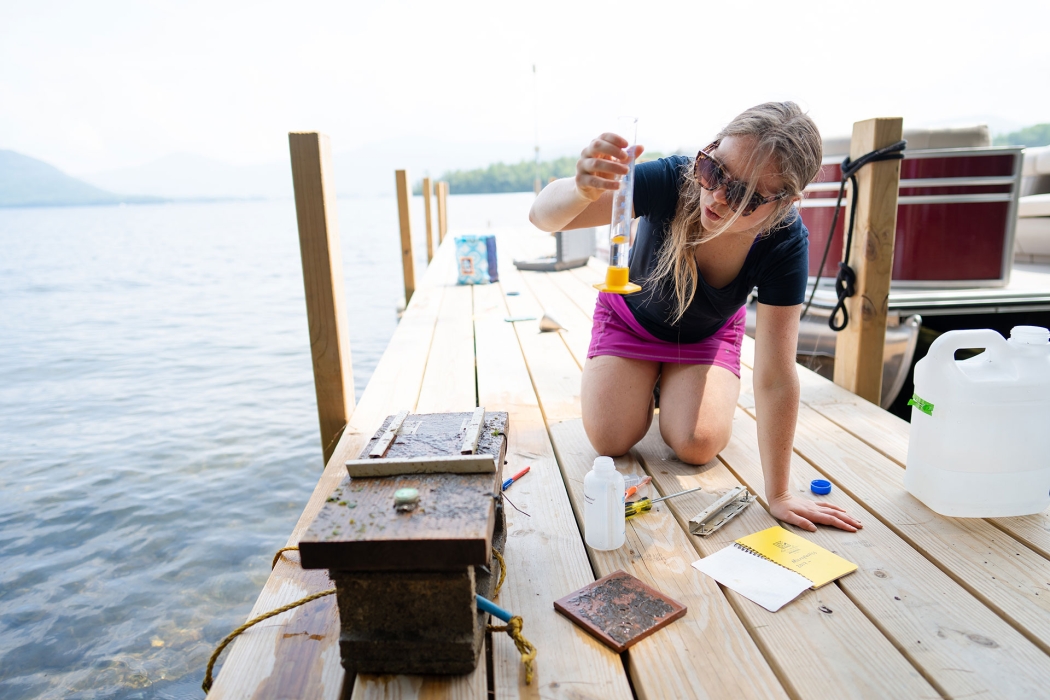How did your time at Union inform your current path?
Union exposed me to everything! I had a wonderful time taking English classes with Professor Shena McAuliffe, doing research with Professor Leo Fleishman and ecology experiments with Professor Kathleeen LoGiudice, gaining confidence as a Career Center peer advisor and studying marine ecology in Australia. While none of these were specifically limnology related, all of these experiences gave me the tools to conquer challenges that I face in graduate school.”
- Cailtin Williams '23, biology graduate student, Rensselaer Polytechnic Institute
Lakes freeze, or sometimes they don’t if the winters are warm. Anyone living in a place like Schenectady knows this. But what we don’t know: Does it matter?
Does it matter to the health of the lake – and its plants and animals – if the water ices over?
Caitlin Williams ’23, a graduate student in biology who is studying lake ecology at Rensselaer Polytechnic Institute, is trying to answer this question. With Lake George (N.Y.) as her laboratory, she is investigating the impacts of winter ice accumulation in what’s called the littoral zone.
“In a nutshell, the littoral zone is the sunlit area near the shore -- the area shallow enough for sunlight to penetrate the water, and the area where photosynthetic organisms can grow on the lake bottom,” Williams said. “My hypothesis is that an increased light environment, caused by less ice in winter, will lead to more algal growth in the nearshore (or littoral) area.”
“It’s not known what effects more/less ice has on algal growth during winter,” she continued. “But climate change is shortening the duration of ice coverage on lakes, and algal growth in the littoral zone is extremely important for understanding the lake’s response to climate change.”
Why is it so important?
Algae are widespread, fast-responding indicators of ecosystem conditions and fluctuations, Williams explained. And because algae are the foundation of the aquatic ecosystem, providing habitat and sustenance to small insects and animals that in turn feed larger ones, any changes in algal distribution impact the entire ecosystem.
“Too much can lead to harmful algal blooms that are dangerous to humans and animals alike,” she added, “but too little algae disrupt the food web and reduce biodiversity.”
Williams had originally planned to begin this work during winter 2023-24, but no ice formed on Lake George that season. So, she pivoted to investigating how winter algal growth facilitates summer algal growth for much of 2024.
Fortunately, she’s been able to use the same tools and similar approaches for both summer and winter research.
“I measure available light under the water in the nearshore area using Hobo light and temperature sensors, which take light and temperature readings every hour,” Williams said.
These sensors are one of two very important tools attached to cinder blocks and sunk at various points around Lake George. The other is six-by-six-inch clay tiles.
These clay tiles provide a place for algae to attach and grow. When it comes time to collect samples, Williams wades out into the lake (no matter the season) and hauls the cinder blocks to shore. There she connects the Hobo sensors to her phone to download light and temperature data, and then she gets out an instrument called a Benthotorch.
“It gives me an instant quantification of how much algae is on the tile, broken down into three types of algae – diatoms, cyanobacteria and green,” Williams said. “Then I carefully scrape the algae off the tile into a vial for later chlorophyll-a analysis and microscopic identification in the lab. This last part is just a check to make sure the Benthotorch identified the algae correctly.”
After she’s collected her data and algae, she returns the cinder blocks – complete with tiles and sensors – to the water.
It’s a process she really enjoys, and one she developed with the help of two alumni.
“I get a much broader perspective when learning from alumni. Mike Kelly ’91 and Jeremy Farrell ’03 were electrical engineering and geology majors, respectively, and they both provide different insights when talking about projects,” Williams said. “I don’t know how to put this into words, but because we are all Union alumni, I feel like this has also given me the ability to talk to Mike and Jeremy as colleagues, even though they have a lot more experience than me.”
Kelly is a senior research engineer at IBM and Farrell is a senior lecturer in biological sciences at RPI and the Darrin Freshwater Institute. The institute is home to The Jefferson Project at Lake George -- a collaboration between Rensselaer Polytechnic Institute, IBM Research and The FUND for Lake George to study fresh water and understand impacts of human activities and how to mitigate those effects.
Williams, whose research is supported by The Jefferson Project, is a student in the laboratory of Kevin Rose, the Frederic R. Kolleck ’52 Career Development Chair in Freshwater Ecology at RPI and acting director of the Darrin Freshwater Institute.
